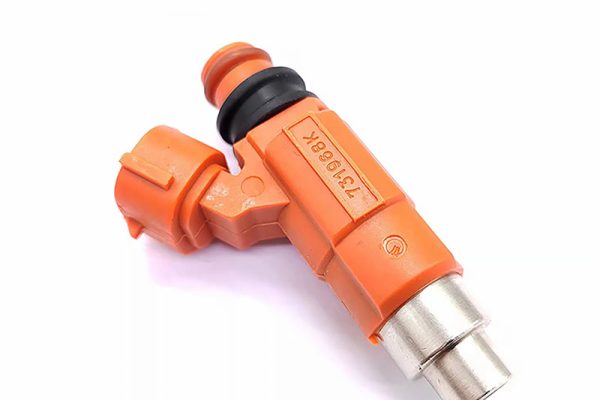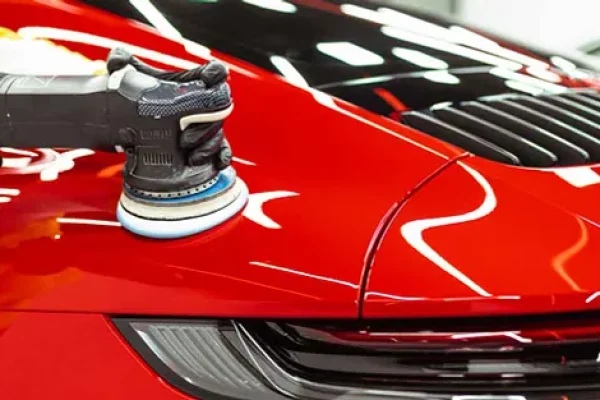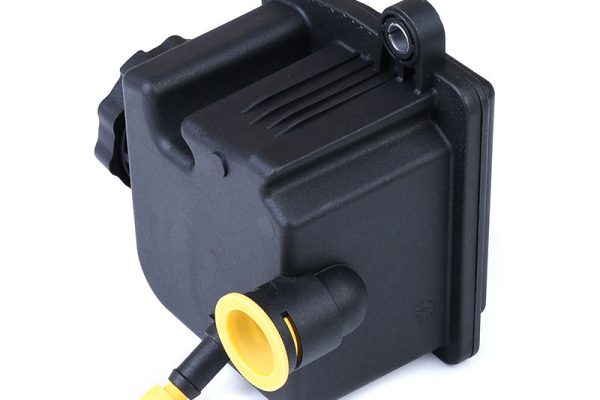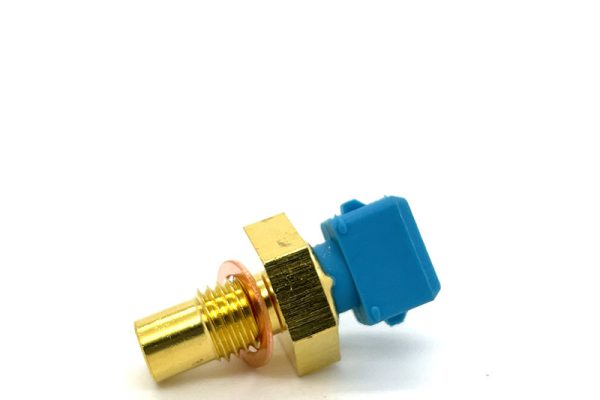Ⅰ. Introduction
Among the many sophisticated systems in the car, the power steering system plays a crucial role, which makes the driver feel light and accurate when controlling the steering wheel. In this system, the power steering fluid reservoir is like the heart, providing a continuous source of power for the entire system. YZHIDIANF will provide kinds of high-quality steering reservoirs. The power steering fluid reservoir not only stores the critical steering fluid, but also ensures the circulation of the fluid in the system, thereby transferring the necessary hydraulic power and reducing the driver’s operation. However, many owners tend to ignore the regular inspection and maintenance of the steering system, resulting in reduced performance and even failure. This article will provide comprehensive maintenance guidelines to help owners ensure that the steering system is always in the best condition to ensure driving safety and driving comfort.
Ⅱ. Structure and working principle of power steering fluid reservoir
1. Structure design of steering fluid reservoirs
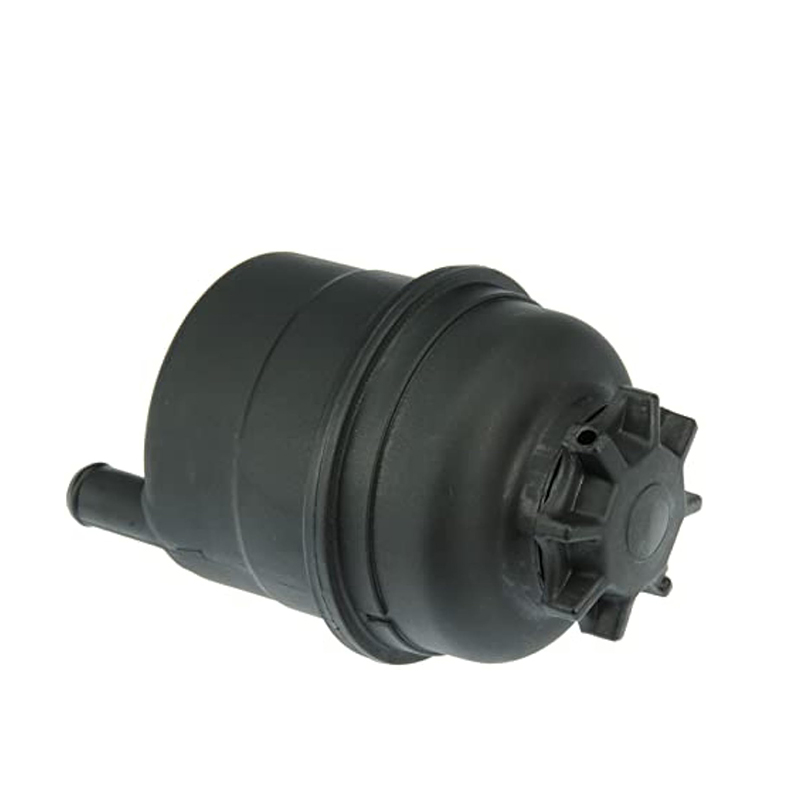
The power steering fluid reservoir is usually made of high temperature and corrosion resistant engineering plastic or metal materials, and the internal design includes key components such as steering fluid container, level observation window, inlet and outlet. The container is its main part, which is a pressure and corrosion resistant container with built-in filter screen and turbulent flow structure to ensure stable fluid storage. The level observation window allows the owner to visually check the stock of steering fluid to ensure that the level is always within a safe range. For example, The power steering reservoir has level monitoring and filtration functions, and improve driving safety to reassure customers. This precise structural design not only improves the reliability of the power steering system, but also extends its service life, which is an important guarantee of vehicle handling performance.
2. Working principle and cycle process
When the driver turns the steering wheel, the steering machine transmits the signal through a mechanical connection to the steering pump, which extracts the steering fluid from the power steering fluid reservoir and pressurizes it to the hydraulic cylinder of the steering machine. The high-pressure fluid pushes the piston in motion, creating a boost that eases the driver’s steering. The circulation structure of the steering fluid is a closed loop. The liquid is pumped and pressurized from the outlet of the storage tank, and then enters the steering machine to complete the assist function. Then, the liquid is returned to the liquid storage tank through the return port, and the impurities are filtered through the filter screen and re-entered the circulation. This efficient circulation structure ensures the stable operation of the power steering system and ensures that the system is always in the best working condition.
Ⅲ. Common failures and diagnosis of power steering fluid reservoir
1. Common failures
(1) Liquid level anomaly
Abnormal fluid level is one of the common faults in power steering system, which may have a serious impact on vehicle handling and safety. Too low liquid level is usually due to steering fluid leakage or long-term failure to replenish, resulting in weakened steering power, heavy steering wheel rotation, and even abnormal sound. If the level is too high, it may be an excess addition or abnormal internal pressure in the system, which may cause liquid overflow or seal damage.
(2) Parts damage
The damage of the power steering fluid reservoir and its related components will directly affect the performance of the power steering system, and even lead to steering failure. Common damages include ruptured storage tanks, aging seals, and leaking connection lines. If the power steering reservoir tank is cracked or damaged, it will cause the steering fluid to leak, and the liquid level will drop rapidly, thus losing the hydraulic power. Aging seals will allow air to enter the system, creating noise and reducing power. In addition, if the pipeline connecting the liquid reservoir is aging or loose, it will also cause leakage, further aggravating the liquid level anomaly. Damage to these components not only affects the driving experience, but also may endanger driving safety.
(3) Pollution and deterioration
Steering fluid pollution and deterioration will seriously affect system performance. The steering liquid may be mixed with impurities such as water, dust, and metal particles during long-term use, resulting in liquid deterioration. The entry of moisture will emulsify the steering fluid and reduce its lubrication and compressive properties. Dust and metal particles will accelerate the wear of the internal components of the system, and even clog the filter and pipe. This is usually related to poor sealing or improper maintenance of the reservoir. In addition, long-term failure to replace the steering fluid will also reduce its performance and lose its due protective effect.
2. Fault diagnosis method
(1) Observational method
Observation is a simple and effective method. First, observe whether the liquid level of the liquid reservoir is within the normal range, the liquid level is too low may indicate the existence of leakage, and the liquid level is too high may be excessive or abnormal system pressure. Second, check the color and texture of the steering liquid, the normal steering liquid is usually transparent or light red, if the liquid is found cloudy, black or contains impurities, it indicates that the liquid has been contaminated or deteriorated. In addition, carefully observe the reservoir and its connecting pipes for leakage traces. Whether the shell of the reservoir is cracked or damaged. Through these intuitive observations, the cause of the failure can be determined preliminarily and provide an important basis for subsequent maintenance. This helps to detect problems early and prevent them from spreading.
(2) Pressure test method
The pressure test method is especially suitable for detecting the working state of the power steering fluid reservoir and its hydraulic circuit. By connecting the special pressure tester, the hydraulic pressure output of the steering pump can be measured to determine whether there is insufficient or excessive pressure in the system. During the test, ensure that the liquid level in the steering reservoir is normal, and check the liquid storage tank and its connecting pipes for leaks. Through the pressure test, you can quickly locate faults and avoid removing and replacing parts blindly. This method not only improves the maintenance efficiency, but also effectively extends the service life of the power steering system to ensure driving safety.
(3) Electronic diagnosis
The electronic diagnosis method is especially suitable for vehicles equipped with electronic power steering systems. By connecting the vehicle diagnostic instrument, the system fault code can be read and the root cause of the problem can be quickly located. For example, if the sensor detects an abnormal storage level, the diagnostics will display the relevant fault code, prompting the owner to check. In addition, electronic diagnostics can also monitor the working status of the steering pump, motor and control module to determine whether there is a circuit fault or signal anomaly. This method can accurately identify faults in electronic components and avoid misjudgments caused by mechanical component problems. By combining liquid level and pressure data, electronic diagnostics can provide a comprehensive assessment of system health, provide a scientific basis for maintenance, and improve the accuracy and efficiency of troubleshooting.
Ⅳ. 3 steps to maintaining your power steering fluid reservoir
1. Regular inspection
Regular inspection is an important measure to ensure the long-term stable operation of the power steering system. It is recommended to carry out a comprehensive inspection every 5000 km or every six months, including the level, liquid status and component tightness. Through regular inspection, problems can be found early, avoiding steering system failures caused by neglect of maintenance, and ensuring driving safety. YZHIDIANF provides many power steering fluid reservoirs and more details about maintenance.
2. Clean and replace the fluid

The repair and replacement of power steering fluid is an important part of vehicle maintenance. If it is found that the steering fluid is abnormal liquid level and color, or the parts are damaged, it needs to be replaced. When replacing, first clean the dust around the liquid storage tank, and then use special tools to extract the old liquid, and clean the inside of the liquid reservoir. YZHIDIANF also advise the measure and you can follow it. “Steering Fluid Container: How to Ensure Driving Safety” has told more ways to protect and you can learn from it. Next, add the new steering fluid that meets the requirements of the model, taking care that the level does not exceed the “MAX” scale. After replacement, start the vehicle and turn the steering wheel left and right, drain the air from the system, and finally check it again.
3. Avoid oversteering
Oversteering can increase the pressure on the steering system, cause the power steering fluid to overheat, accelerate the aging of the fluid, and may even damage the steering pump and seals. Especially when the vehicle is stationary or traveling at low speeds. It’s beneficial to extend the service life of the steering fluid container, maintain the efficient operation of the system, and improve the driving experience.
Ⅴ. 3 ways to choose the right products
1. Type selection
(1) Hydraulic power steering system
In the hydraulic power steering system, the types of power steering fluid reservoir are mainly divided into two types: integrated and independent. The integrated reservoir is usually designed as one with the steering pump, which is compact and space-saving, and is commonly found in some compact vehicles. For example, The Power Steering Reservoir 57150-2D000 is a classical product which can ensure efficient storage and circulation. It uses a high temperature resistant (-40 degrees to 150 degrees) material to ensure that it doesn’t deform or crack under extreme conditions. The independent steering reservoir is installed separately in the engine compartment, and is mostly used for medium and large vehicles. Regardless of the type, the power steering fluid reservoir performs the important function of storing, filtering and supplying the steering fluid.
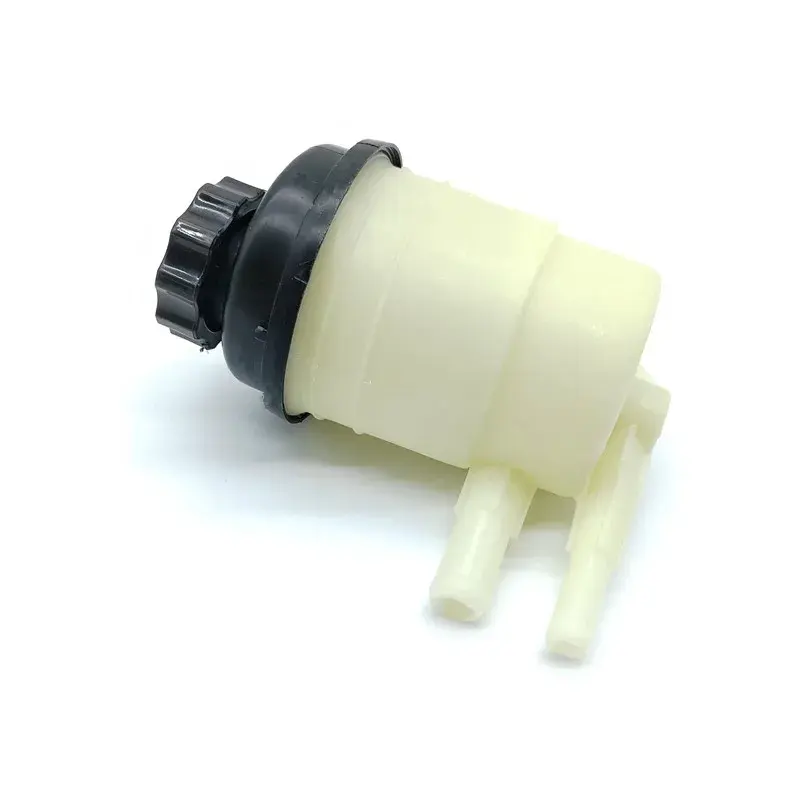
(2) Electric power steering system
In electric power steering systems, because of the use of electric power rather than hydraulic power, traditional reservoir is usually not required. EPS systems provide steering power directly via sensors and electronic control units, eliminating the need for hydraulic circuits and steering fluids. However, some hybrid steering systems retain the hydraulic assist function and are equipped with a small power steering fluid reservoir for storing and supplying small amounts of steering fluid. This design combines the efficiency of the electric assist with the reliability of the hydraulic system and is suitable for specific models. Overall, the simplified structure of the EPS system reduces maintenance requirements while improving energy efficiency. Selecting the right type of power steering reservoir tank according to the vehicle design and space layout can improve the reliability and maintenance convenience of the system.
2. Selection principle
(1) Clear demand
Choosing the right power steering fluid reservoir first needs to be clear about the specific needs of the vehicle. The design of the power steering system varies from model to model, and the type, capacity and installation location of the liquid reservoir also vary. For example, a hydraulic power steering system requires a larger capacity of power steering fluid storage, while an electric power steering system may require only a small fluid reservoir. And if your car is a BMW, YZHIDIANF will offer world-class bmw auto parts and perfect after-sales service. In addition, it is also necessary to consider the driving environment and frequency of use of the vehicle, frequent driving or harsh road conditions, the durability and tightness of the liquid reservoir is particularly important. After these requirements are clear, the appropriate product can be selected to ensure the stability and maintenance convenience of the steering system.
(2) Comparison
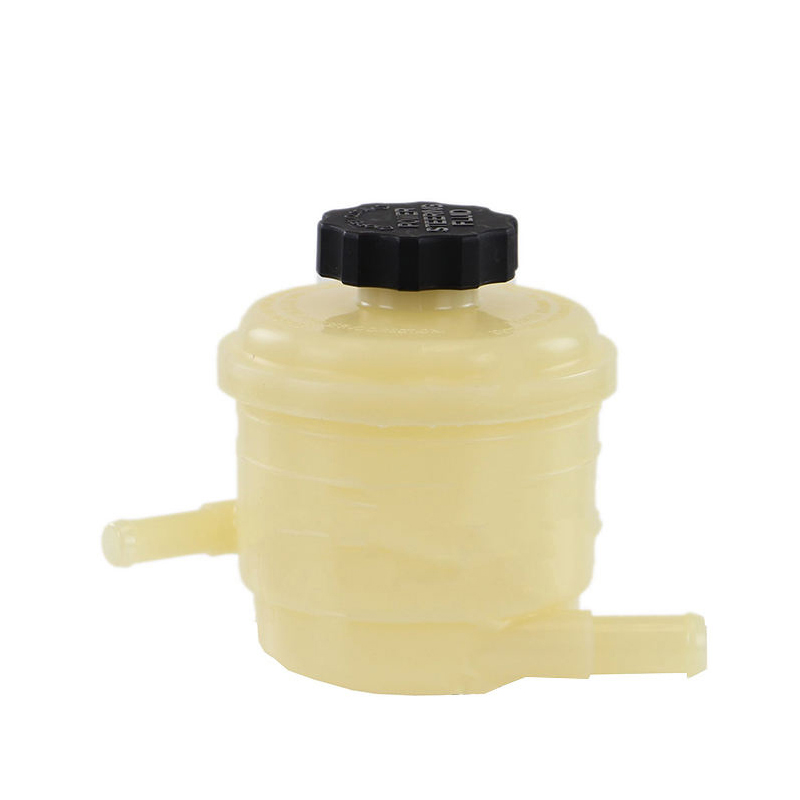
It is important to follow the principle of comparison. The brand, material and price of liquid reservoirs on the market differ greatly, and the owner should compare the performance and quality of different products according to the vehicle model and demand. First, choose well-known brands or original accessories to ensure the durability and compatibility of the power steering fluid reservoir. Second, compared with the material, the steering fluid container made of high-quality engineering plastic or metal is more resistant to high temperature and corrosion. Finally, combine the price and after-sales service, choose cost-effective products. For example, The Power Steering Reservoir 57150-25000 uses high-quality materials and suitable for a variety of models of Accent. It has high cost performance. Through multi-party comparison, we can find products that meet the budget and performance requirements, and ensure the long-term stable operation of the steering system.
3. Compatibility considerations
First, it is necessary to confirm whether the model, specification and material of the reservoir and the vehicle power steering system match to ensure good sealing and avoid leakage. At the same time, the compatibility of the reservoir to the power steering fluid should be considered to prevent performance degradation due to chemical reactions. Choosing the compatible power steering fluid reservoir is an important premise to ensure the stable operation of the steering system. Besides, “Power steering reservoir manufacturer: How to select high-quality products” will tell you more information to help you choose right products.
Ⅵ. Future development trend
1. Technological innovation
With the acceleration of the automotive intelligence trend, the design of liquid reservoirs will be more integrated and lightweight, using high-strength composite materials to improve durability and reduce weight. At the same time, the introduction of intelligent sensor technology will enable the power steering fluid reservoir to have the function of real-time monitoring of liquid level, temperature and liquid status, and remind the owner of maintenance through the on-board system. These technological innovations will not only improve the performance of the reservoir, but also drive the power steering system to a more efficient and intelligent direction. Besides, “Power Steering Fluid Reservoir Supplier: Your Wonderful Driving Partner” gives more pros of YZHIDIANF and it proves that it’s a reliable choose.
2. Environmental protection and sustainability
With the increase of environmental protection requirements worldwide, YZHIDIANF will prioritize the use of recyclable materials, such as bio-based plastics or recycled metals, to reduce resource consumption and environmental pollution. In addition, the design will optimize tightness and durability, reduce the risk of leakage, and avoid contamination of soil and water with steering fluids. These initiatives not only enhance the sustainability of power steering fluid reservoir, but also promote the transformation of the automotive industry to a green direction and contribute to environmental protection.
Ⅶ. Conclusion
As the heart of automobile steering system, the importance of power steering fluid reservoir is self-evident. Regular inspection and maintenance can not only extend the service life of the reservoir, but also ensure the smooth operation of the steering system and improve driving safety. Therefore, hopefully this guide will give you useful information to ensure that the steering reservoir is always in top condition. I believe that power steering fluid reservoirs will develop in a smarter and more environmentally friendly direction, injecting new vitality into the automotive industry.



